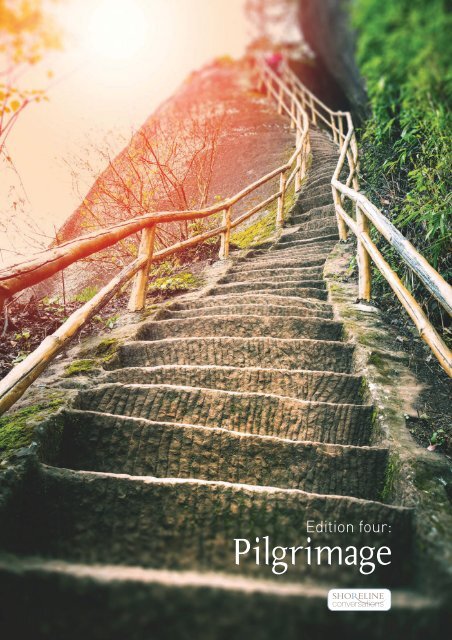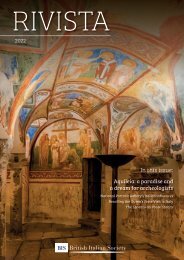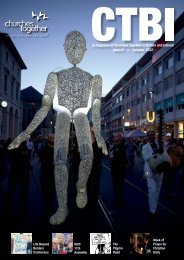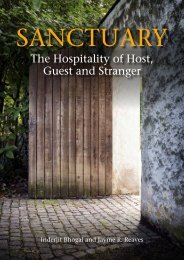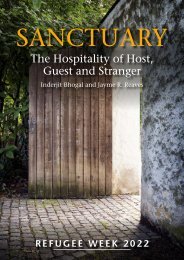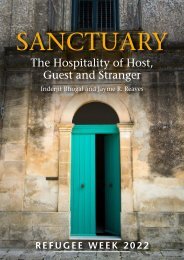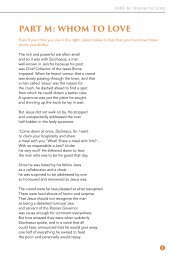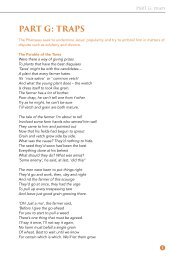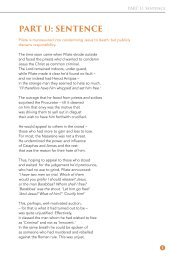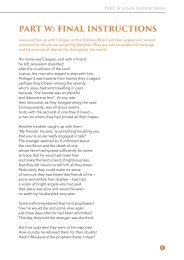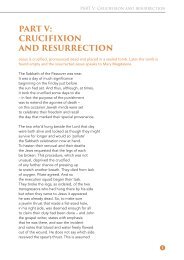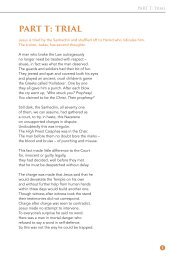Pilgrimage
Within our increasingly secular culture, many seek spiritual sustenance as we negotiate the challenges of life, looking for purpose and direction in a rapidly changing scene. In the midst of busy lives, taking time and space to find oneself remains an attractive proposition, which the relative anonymity of a pilgrim journey can provide. Whether we are seasoned pilgrims or armchair dreamers, we will find sustenance for our spiritual journey in the words, wisdom and beautiful images of these conversation packs.
Within our increasingly secular culture, many seek spiritual sustenance as we negotiate the challenges of life, looking for purpose and direction in a rapidly changing scene. In the midst of busy lives, taking time and space to find oneself remains an attractive proposition, which the relative anonymity of a pilgrim journey can provide. Whether we are seasoned pilgrims or armchair dreamers, we will find sustenance for our spiritual journey in the words, wisdom and beautiful images of these conversation packs.
Create successful ePaper yourself
Turn your PDF publications into a flip-book with our unique Google optimized e-Paper software.
Edition four:<br />
<strong>Pilgrimage</strong><br />
editions • Glimpsing God 1<br />
Editions 4.indd 1 23/11/2015 15:07
9 780851 693958<br />
© The Shoreline Consultancy 2015<br />
Conversation 3 Becoming Present.indd 1 17/11/2015 15:12<br />
wallet.indd 1 16/11/2015 12:01<br />
John 14: 26<br />
<strong>Pilgrimage</strong><br />
conversation one<br />
<strong>Pilgrimage</strong><br />
the open road<br />
conversation two<br />
the open road<br />
taking and leaving<br />
becoming present<br />
alone and together<br />
living with uncertainty<br />
sacred encounter<br />
pilgrim living<br />
<strong>Pilgrimage</strong><br />
To become a pilgrim is to undertake a particular<br />
kind of journey, a sacred journey which involves<br />
both inner and outer dimensions. Among the<br />
varied reasons people give for deciding to take<br />
such a step, it is often possible to discern a sort<br />
of longing – a desire for something different, for<br />
something deeper than the everyday.<br />
Within our increasingly secular culture, many seek spiritual<br />
sustenance as we negotiate the challenges of life, looking<br />
for purpose and direction in a rapidly changing scene.<br />
In the midst of busy lives, taking time and space to find<br />
oneself remains an attractive proposition, which the relative<br />
anonymity of a pilgrim journey can provide. Whether we<br />
are seasoned pilgrims or armchair dreamers, we will find<br />
sustenance for our spiritual journey in the words, wisdom and<br />
beautiful images of these conversation packs.<br />
⟢ ⟡ ⟣<br />
<strong>Pilgrimage</strong><br />
the open road<br />
taking and leaving<br />
becoming present<br />
alone and together<br />
living with uncertainty<br />
sacred encounter<br />
pilgrim living<br />
taking and leaving<br />
A pilgrim journey brings into sharp relief much<br />
that we gloss over or take for granted, bringing to<br />
attention those things we truly value. Because of<br />
our decision to be on the move, we are somehow<br />
obliged to make choices about what is essential<br />
and what is peripheral. Life is a process of<br />
continual change and movement in which we look<br />
for patterns and significance. Beyond the whirling<br />
cycle of our days we find tha there still remains a<br />
longing for that which is lasting and eternal.<br />
On pilgrimage we have the opportunity to sift<br />
experience and to choose again those things<br />
we require for inner vitality and balance. But<br />
it may also become clear that we have to shed<br />
other things, which may once have helped us but<br />
which we now find burdensome and obstructive<br />
– be they tasks, habits, ideas, beliefs or even<br />
relationships.<br />
conversation three<br />
However, we must proceed with caution, for<br />
taking and leaving cannot be made lightly. If we<br />
are to be prophetic to an insatiable world, which<br />
uses up and discards too quickly, our choices<br />
should reflect the generosity of God in the way we<br />
share, re-imagine and preserve all that is good.<br />
“Come to me, a l you who are weary and burdened, and I wi l give you rest.”<br />
Within our increasingly secular culture, many<br />
still seek spiritual sustenance as they try and<br />
negotiate the challenges of life. For some, there<br />
appears to be a crisis of hope and they look<br />
for purpose and direction in a rapidly changing<br />
scene. In the midst of busy mobile lives,<br />
taking time and space to find yourself remains<br />
an attractive proposition, which the relative<br />
anonymity of a pilgrim journey can provide.<br />
<strong>Pilgrimage</strong> is the fourth of a series of resource packs<br />
designed to invite personal reflection and promote spiritual<br />
conversation in a variety of settings.<br />
the open road<br />
taking and leaving<br />
becoming present<br />
alone and together<br />
living with uncertainty<br />
sacred encounter<br />
pilgrim living<br />
<strong>Pilgrimage</strong><br />
becoming present<br />
conversation four<br />
Pilgrims, while travelling in hope of Divine<br />
blessings, learn to free themselves of particular<br />
expectations. By becoming truly available to the<br />
present moment we may gently leave behind, for<br />
a while, both regret and ambition. If we manage<br />
to remain so attentive and keep our hearts open<br />
to new experiences we will be amply rewarded,<br />
for wisdom from the past re-emerges in the<br />
present and is charged with new perspectives.<br />
For those physically undertaking a pilgrim<br />
journey, unfamiliar surroundings and new<br />
companions provide a landscape to be explored.<br />
Making space to receive in gratitude what has yet<br />
to be discovered is helpfully complemented by<br />
a determination to embrace and enjoy the gaps<br />
between our plans.<br />
Yet although the classical image of the pilgrim<br />
is one who moves from one place to another,<br />
it is also possible to be on pilgrimage without<br />
leaving familiar territory. By embracing a<br />
deepening quality of attentiveness we can gain<br />
new perspectives in the here and now. In doing<br />
so we can undertake an inward journey and, in<br />
becoming for a time more open to God, we may<br />
see things anew and afresh, marvelling at what<br />
we thought we had already known.<br />
“Look at the birds of the air; they do not sow or reap or store away in barns, and yet<br />
your heavenly Father feeds them.”<br />
Matt 6: 26<br />
Matt 11: 28<br />
Conversation 2 Taking and Leaving.indd 1 17/11/2015 15:12<br />
For believers, pilgrimage is also about<br />
rediscovering how the stories of our lives fit into<br />
a wider context. It is about re-connecting with<br />
the wider Christian story, which is so deeply<br />
embedded in our history and culture. As we walk<br />
in the footsteps of pilgrims from earlier times, we<br />
may find ourselves caught up in their experience<br />
and the perennial invitation to journey again with<br />
our travelling God.<br />
We are grateful for the sponsorship of<br />
this resource by Churches Together in<br />
Britain and Ireland who suggested the<br />
overall theme and also contributed to<br />
its production.<br />
Jesus, full of the Holy Spirit, left the Jordan and was led by the Spirit into the wilderness,<br />
where for forty days he was tempted by the devil.<br />
Luke 4: 1-2<br />
www.shorelineconversations.com<br />
Conversation 1 The Open Road.indd 1 17/11/2015 15:11<br />
r<br />
<strong>Pilgrimage</strong><br />
the open road<br />
taking and leaving<br />
becoming present<br />
alone and together<br />
living with uncertainty<br />
sacred encounter<br />
pilgrim living<br />
<strong>Pilgrimage</strong><br />
alone and together<br />
Every faith journey is unique to the individual<br />
concerned, cerned, even though there are patterns and<br />
similarities between us. As pilgrims we have a<br />
two-fold opportunity: to spend time in solitude<br />
reflecting on our own; and to enter conversation<br />
with fellow travellers committed to the same<br />
endeavour.<br />
conversation five<br />
<strong>Pilgrimage</strong><br />
Our ultimate guide, of course, is the Holy Spirit<br />
whose presence we discern in the unfolding of the<br />
journey and companionship of those we might not<br />
otherwise meet. et. For the normal cultural and social<br />
barriers become eroded on pilgrimage and we are<br />
informed by the stories of others, particularly those<br />
with whom we share bread and table. We gradually<br />
begin to trus these companions and our horizons<br />
are widened as a consequence.<br />
Pilgrims throughou the ages have sough to<br />
offer practical assistance to other travellers,<br />
recognizing their own dependence on the kindness<br />
of others. As we journey on we are invited to<br />
reflect on the experience of the many people on<br />
the move throughou the world today. These global<br />
companions include the refugees and asylum<br />
seekers we hear about so frequently, often fleeing<br />
war and persecution, both secular and religious, in<br />
search of a better life.<br />
As they talked and discussed these things with each other, Jesus himself came up and<br />
walked along with them; bu they were kept from recognising him.<br />
Luke 24: 15-16<br />
conversation six<br />
the open road<br />
taking and leaving<br />
becoming present<br />
alone and together<br />
living with uncertainty<br />
sacred encounter<br />
pilgrim living<br />
living with uncertainty<br />
There may be times during our pilgrimage when<br />
the journey becomes more difficult. We travel in<br />
faith rather than certainty and there are periods<br />
when we may even lose our sense of direction.<br />
Ye these painful passages have much to teach<br />
us abou the reality of the human condition and<br />
our dependence on God and other people. Many<br />
who walked this way before us as fellow seekers<br />
or followers of Jesus, experienced times of<br />
abandonment when they listened in vain for ‘the<br />
still, small voice’.<br />
the open road<br />
taking and leaving<br />
becoming present<br />
alone and together<br />
living with uncertainty<br />
sacred encounter<br />
pilgrim living<br />
<strong>Pilgrimage</strong><br />
sacred encounter<br />
conversation seven<br />
The ebb and flow of the pilgrim journey finally<br />
gives way to the proximity of our chosen<br />
destination. To this sacred place we have come<br />
to seek some form of encounter er with Divinity. Yet<br />
these things cannot be conjured up, assumed<br />
or taken for granted. Sometimes our point of<br />
arrival raises more questions than it answers,<br />
particularly when first approached.<br />
To be a pilgrim is to experience a certain amount<br />
of alienation, for you are taking a different route<br />
to many of your fellow citizens. This sense of<br />
dislocation is found in the original meaning of<br />
‘pilgrimage’ which comes from the Latin word<br />
‘peregrinus’. This carries the idea of ‘passing<br />
through’ somewhere which may not be one’s<br />
ultimate destination.<br />
pilgrim living<br />
Patience is often required as we contemplate the<br />
mystery of God and renew our acquaintance with<br />
the essence of the Christian story. Here we find<br />
a profoundly counter-cultural message in the<br />
stories and the images we find – no more so than<br />
in the journey of Jesus to Calvary ary and beyond.<br />
So even if the culture in which we live seems<br />
increasingly inhospitable, we must cling to the<br />
hope in our hearts and not be discouraged.<br />
There remain rumours of transcendence in the<br />
unexpected encounters along the way and our<br />
promised true home is heaven itself.<br />
Conversation 4 Alone and Together.indd 1 17/11/2015 15:12<br />
From this time many of his disciples turned back and no longer fo lowed him.<br />
‘You do not wan to leave too, do you?’ Jesus asked the Twelve.<br />
John 6: 66-67<br />
the open road<br />
taking and leaving<br />
becoming present<br />
alone and together<br />
living with uncertainty<br />
sacred encounter<br />
pilgrim living<br />
The return to norma life brings both joys and<br />
challenges. The value of any sacred journey is<br />
most clearly seen in the frui that is produced<br />
in the lives of those involved. In the period after<br />
we return home we are invited to reflect on how<br />
have we been changed by the experience both<br />
for ourselves and for others. Often the answer<br />
is more than jus that of an individual response.<br />
We return to Christian communities who have<br />
been raised up to present a message of hope<br />
to the world. But our churches, too, are on a<br />
pilgrim journey, trying to relate in new ways to<br />
a society which views what we have to offer with<br />
scepticism and suspicion.<br />
Many Christians have rightly sought to relieve the<br />
sufferings of others, yet somewhere in our faith<br />
tradition is the belief that suffering is something<br />
that may be learned from, strangely embraced<br />
and somehow turned to profound significance.<br />
Waiting in the silence, as before the empty tomb,<br />
we are invited to consider the reality of pain and<br />
loss and wonder with growing confidence in the<br />
God who makes life out of death, goodness out<br />
of evil; and reconciliation out of discord in the<br />
triumph of the resurrection.<br />
Conversation 5 Living with Uncertainty.indd 1 17/11/2015 15:13<br />
Perhaps in the notion of pilgrimage there are<br />
grounds for optimism. Holding on to our own<br />
heritage and our faith in Christ, we can journey<br />
with others in renewed confidence. As living<br />
examples of reconciliation, can we not mend<br />
relationships and encourage the creation of new<br />
networks of solidarity and connection? In ways<br />
that demonstrate the love of God for everyone,<br />
we can be life-long pilgrims, constantly seeking<br />
renewal and transformation in the light of the<br />
resurrection of Jesus.<br />
Jesus called out with a loud voice, ‘Father, into your hands I commit my spirit.’<br />
When he had said this, he breathed his last.<br />
Luke 23: 46<br />
Conversation 6 Sacred Encounter.indd 1 17/11/2015 15:13<br />
<strong>Pilgrimage</strong><br />
“The Holy Spirit, whom the Father wi l send in my name, will teach you a l things and wi l<br />
remind you of everything I have said to you.”<br />
Conversation 7 Pilgrim Living .indd 1 18/11/2015 13:47<br />
<strong>Pilgrimage</strong><br />
Within our increasingly secular culture, many<br />
seek spiritual sustenance as we negotiate the<br />
challenges of life, looking for purpose and<br />
direction in a rapidly changing scene. In the<br />
midst of busy lives, taking time and space to find<br />
oneself remains an attractive proposition, which<br />
the relative anonymity of a pilgrim journey can<br />
provide. Whether we are seasoned pilgrims or<br />
armchair dreamers, we will find sustenance for<br />
our spiritual journey in the words, wisdom and<br />
beautiful images of these conversation packs.<br />
<strong>Pilgrimage</strong> is the fourth of a series of resource<br />
packs designed to invite personal reflection and<br />
promote spiritual conversation in a variety of<br />
settings.<br />
We are grateful for the sponsorship of this<br />
resource by Churches Together in Britain and<br />
Ireland who suggested the overall theme and also<br />
contributed to its production.<br />
Forthcoming packs and Editions in the series<br />
will include Soul at Work. Also available are<br />
Glimpsing God, Journeying Spiritually with<br />
Children and Aloneness.<br />
www.shorelineconversations.com<br />
© Shoreline Conversations 2015<br />
Published by Shoreline Conversations<br />
Venture House<br />
93 Telegraph Road<br />
Heswall<br />
Wirral CH60 0AE<br />
w: www.shorelineconversations.com<br />
e: info@shorelineconversations.com<br />
Edited by Lynne Ling<br />
e: lynne.ling@shorelineconversations.com<br />
t: 07734 607486<br />
Design by 25 Educational<br />
w: www.base25.com<br />
e: mark@base25.com<br />
t: 0151 632 1657<br />
Editions 4.indd 2 23/11/2015 15:07
Edition four:<br />
<strong>Pilgrimage</strong><br />
Welcome to our fourth issue of Editions, created to complement the conversation<br />
packs we will be producing at regular intervals over the next few years.<br />
r<br />
Stephen Wright, who wrote for the last Edition about journeying spiritually<br />
with his grandchildren, this time turns his attention to pilgrim journeys he<br />
has taken and people he has met.<br />
y Sarah Friswell works in a cathedral which seeks to welcome visitors<br />
as modern-day pilgrims and meet their needs in a spirit of Benedictine<br />
hospitality.<br />
i Elizabeth Rundle takes us on an armchair pilgrimage around the Holy<br />
Land, where the stories of the Old and New Testaments come to life.<br />
a Paul Heppleston leads small groups of travellers to remote places and<br />
here reflects for us on the spiritual challenges and delights of being ‘away<br />
from it all’.<br />
Paul’s article includes the sentence: ‘Every journey calls us to leave home-base<br />
and venture out into what may be the unknown, returning home with a renewed<br />
perspective on life and on the place where we started.’<br />
We hope that the material in this magazine, together with the <strong>Pilgrimage</strong><br />
conversation pack and the website www.lentpilgrimage.org.uk will nurture in<br />
you a desire not only to travel to new places geographically, but also to be willing<br />
to face up to places outside your comfort zone in every aspect of life, ready to<br />
learn and to grow in faith, wisdom and understanding as a life-long journey.<br />
Lynne Ling<br />
Editor<br />
editions • <strong>Pilgrimage</strong><br />
e<br />
Editions 4.indd 3 23/11/2015 15:07
PILGRIMAGE<br />
ISN’T JUST FOR THE HOLY<br />
Stephen Wright shares insights from pilgrimages he has undertaken<br />
in beautiful landscapes and industrial wastelands<br />
My first (forced) pilgrimage was at school –<br />
made to read Chaucer’s Canterbury Tales.<br />
The elements of the classic pilgrimage (Latin<br />
‘peregrinus’ - stranger or wanderer) are found<br />
therein; groups or individuals journeying to a religious<br />
shrine in search of healing or spiritual guidance. The film<br />
‘The Way’ exemplifies the contemporary combination of a<br />
tough physical journey, prayer and worship, encounters<br />
with persons and places, all of which challenge us inwardly,<br />
shaking and shifting our perceptions of self, others, faith<br />
and God.<br />
<strong>Pilgrimage</strong> of all sorts, long or short, has become hugely<br />
popular again. Well-known, traditional routes like that to<br />
Santiago de Compostela (requiring resources and ability<br />
to walk many hundreds of miles) contrasts with the trend<br />
toward self-created routes. Almost invariably ‘walked’ (feet<br />
on the ground seems to aid the shift of consciousness) I<br />
have recently met people going from Durham Cathedral<br />
to the Angel of the North to lay a wreath, another group<br />
walking the stone circles of the Isle of Lewis, yet another<br />
following ley lines to Glastonbury Tor.<br />
It’s not just the journey that matters, but the consciousness<br />
with which we do so. If we travel to any sacred site to<br />
marvel, photograph and gather facts we will have a very<br />
different experience than a reverent approach seeking to<br />
deepen our relationship in God. As the former we are mere<br />
tourists, the latter true pilgrims.<br />
A couple of years ago I pilgrimaged from Iona to Glasgow.<br />
Over 13 days and 155 miles I passed through bucolic idyll<br />
and industrial wasteland, stayed in nurturing B&B’s and<br />
some rubbish ones, traversed mountain and valley, sailed<br />
can we also find God in the people we meet<br />
along the way who challenge us, in places<br />
that are not glorious or in the detritus in<br />
the street?<br />
r<br />
Shoreline Conversations<br />
Editions 4.indd 4 23/11/2015 15:07
pilgrimage stretches us<br />
at every level, physical,<br />
psychological, spiritual…<br />
across ocean and loch and tramped through bog and along<br />
city streets. I met folks of all sorts of along the way, had<br />
conversations rich or shallow, and was often asked “Why<br />
Iona to Glasgow? Surely it should be the other way round?”<br />
Such judgements create dualism; God in this place but not<br />
in that place.<br />
Lately pilgrimaging around Cumbria, creating a circuit<br />
connecting the Mungo/Kentigern churches around the<br />
Northern Fells, I found myself again questioning the notion<br />
of some places as sacred, others not. Certainly it can<br />
seem easier to see God in beautiful landscapes or loving<br />
encounters. But can we also find God in the people we<br />
meet along the way who challenge us, in places that are not<br />
glorious or in the detritus in the street?<br />
As I have grown older I have come to appreciate that the<br />
sacred is everywhere. There is nowhere that God is not.<br />
Perhaps that is one of the ‘products’ of pilgrimage – an<br />
evolution of consciousness, of realisation that it’s not<br />
about where we are in place and time, but our awareness<br />
of God wherever and whenever that matters. Thus, we do<br />
not necessarily have to endure some arduous journey over<br />
great distances and at great cost (in many senses) – even<br />
the thought of that can put people off. <strong>Pilgrimage</strong> isn’t just<br />
for the ‘holy’ or those who feel the need to struggle. A short<br />
walk to church, the effort to find time and place at home to<br />
meditate, walking the labyrinth of our interior realm as well<br />
as a labyrinthine journey in physical reality; this everyday<br />
interplay of one with the other that creates transformation<br />
in our relationship with self, the world, God is perhaps the<br />
essence of pilgrimage.<br />
We do not have to suffer on pilgrimage – to travel half the<br />
way on our knees or stretch our bodies beyond limits. The<br />
thought that we only gain something if it hurts is suspect.<br />
The consciousness with which we approach pilgrimage –<br />
the surrender of the will, the intention, the desire to make<br />
the effort – is of equal if not greater importance.<br />
It’s not so much where we pilgrimage, but that we<br />
pilgrimage. Through prayer and effort in faith, working<br />
through scripture, opening to the guidance of spirit, all<br />
these and more, we come to know that the sacred we<br />
seek is within. The outer journey however long or short<br />
paradoxically takes us deeper inwards. The place to which<br />
we pilgrimage and encounter God most readily is in that<br />
“inner chamber” to which Jesus pointed (Matthew 6:6).<br />
<strong>Pilgrimage</strong> stretches us at every level, physical,<br />
psychological, spiritual. That’s what pilgrimage does to<br />
us, yes does to us. Although we do all the walking and<br />
organising, it may become clear to us that it was not so<br />
much that we take a pilgrimage, but that pilgrimage takes<br />
us. On my own journeys I realised I had not so much sought<br />
God, but that God had sought me.<br />
if we travel to any sacred site to marvel,<br />
photograph and gather facts we will<br />
have a very different experience than a<br />
reverent approach seeking to deepen our<br />
relationship in God<br />
Stephen Wright is an ordained<br />
interfaith minister and member<br />
of the Iona Community living in<br />
Cumbria. He works as a spiritual<br />
director for the Sacred Space<br />
Foundation.<br />
The Sacred Space Foundation,<br />
Fell End, Mungrisdale,<br />
Cumbria CA11 0XR<br />
t: 01768 77983<br />
w: www.sacredspace.org.uk<br />
e: jeannie@sacredspace.org.uk<br />
editions • <strong>Pilgrimage</strong><br />
t<br />
Editions 4.indd 5 23/11/2015 15:07
HERITAGE<br />
HOSPITALITY<br />
Sarah Friswell considers what our heritage sites can offer the modern day pilgrim<br />
y<br />
Shoreline Conversations<br />
Editions 4.indd 6 23/11/2015 15:07
When I first came to work at St Edmundsbury<br />
Cathedral I quickly learned that the context<br />
in which I would be working had grown out of<br />
the Benedictine heritage, with the Abbey of<br />
St Edmund being a major centre of pilgrimage in medieval<br />
England. Welcome therefore was and is paramount and<br />
the ‘right’ sort of welcome – a Christ-like welcome for all -<br />
imperative.<br />
More recently, I have taken on the role of volunteer Chair<br />
of the Methodist Heritage Committee. The Methodist<br />
understanding of heritage is not so much to do with history<br />
as it is with the intentional mission opportunity that our<br />
heritage provides. Why are our chapels ordered as they<br />
are – often with the pulpit central? Why do most people<br />
think that all Methodists are teetotal? Being engaged in<br />
Methodist heritage is about using those distinctly Methodist<br />
ideologies or practices to tell others of our faith and to<br />
encourage them to explore faith issues themselves.<br />
welcome is paramount and the ‘right’<br />
sort of welcome – a Christ-like welcome<br />
for all – imperative<br />
So are modern day tourists exactly the same as medieval<br />
pilgrims? There are similarities.<br />
In medieval times, the popularity of a shrine or sacred site<br />
depended on the number of saintly miracles attributed.<br />
Popularity is still a key feature today. The honey pots attract<br />
huge numbers, whereas smaller lesser known places often<br />
struggle to get noticed. Nowadays we use modern media to<br />
promote ourselves and win new and repeat visitors. Even in<br />
medieval times your loyalty to a shrine counted, meaning<br />
less time in purgatory.<br />
Tourists love a good cup of tea and somewhere to buy a<br />
small gift of their visit (their modern day equivalent of a<br />
pilgrim’s badge) – just the same as a medieval pilgrim.<br />
We need to meet their needs, in a spirit of Benedictine<br />
hospitality.<br />
Of course there are differences. Today we get in our cars,<br />
coaches and trains and travel at speed. The medieval<br />
pilgrim used his feet, at best a horse, and made a time<br />
consuming commitment to go on pilgrimage.<br />
my experiences have led me to<br />
the belief that people who visit<br />
churches are potential pilgrims<br />
A recent response recorded in the visitors’ book at Englesea<br />
Brook Chapel and Museum of Primitive Methodism<br />
indicates the importance of what is being done: “A very<br />
special place to learn about our Methodist heritage.<br />
Thanks for a warm welcome.” And those offering welcome<br />
are affected too. A volunteer on duty at City of Edinburgh<br />
Methodist Church for an open day commented: “It was<br />
absolutely fascinating to have people genuinely curious and<br />
opening up about themselves and their concerns.”<br />
My experiences over the last few years have led me to the<br />
belief that in fact people who visit churches are potential<br />
pilgrims. Those of us in the church need to provide an<br />
authentic and transformational experience for them – even<br />
if the visitors themselves would never call their visit a<br />
pilgrimage.<br />
In the mid 1990s a review of the work of cathedrals was<br />
undertaken and published in a report called Heritage and<br />
Renewal, in which it states:<br />
For all its potential dangers, mass tourism and travel<br />
ought to be welcomed as often powerful means<br />
of opening closed minds. Any church interested in<br />
ministry and mission cannot but be interested in all<br />
kinds of people on the move, and be willing to face the<br />
reality that people inevitably affect places.<br />
Many of our visitors say that they believe in God but yet don’t<br />
attend church. We hear a lot about spiritual ‘searching’.<br />
<strong>Pilgrimage</strong>s to the traditional sites (or indeed to new<br />
ones) or to mark anniversaries seem to be very popular.<br />
They provide a valid expression of pilgrimage – journey,<br />
companionship on the road, interaction with communities<br />
and a personally life-changing experience. If you add in<br />
factors such as the health benefits of walking, it begins to<br />
look very attractive as a way to spend some ‘quality’ time.<br />
The popularity of pilgrimage is growing – it’s on the TV,<br />
there are books on the topic and the word is used in secular<br />
as well as sacred settings. I believe the potential to awaken<br />
spiritual journeying in our secular world is there and the<br />
church needs to grasp this opportunity. We are all on a<br />
journey – life’s pilgrimage – and the places we go, people<br />
we meet, conversations we have enrich us immeasurably on<br />
the way. <strong>Pilgrimage</strong> provides a way of bringing the sacred<br />
and secular together.<br />
Sarah Friswell is PR, <strong>Pilgrimage</strong> and Visits Manager of<br />
St Edmundsbury Cathedral and Chair of the Methodist<br />
Heritage Committee (www.methodistheritage.org.uk)<br />
The Cathedral Office<br />
Abbey House, Angel Hill<br />
Bury St Edmunds<br />
Suffolk IP33 1LS<br />
t: 01284 748726<br />
w: www.stedscathedral.co.uk<br />
e: pr.manager@stedscathedral.org<br />
editions • <strong>Pilgrimage</strong><br />
u<br />
Editions 4.indd 7 23/11/2015 15:07
in the footsteps<br />
OF JESUS<br />
Elizabeth Rundle, a Methodist minister who has accompanied pilgrims to Israel/Palestine<br />
regularly over the last 26 years, shares some of the highlights of her visits<br />
<strong>Pilgrimage</strong>, what’s that, you ask? So different from<br />
a holiday in that a pilgrimage seeks to engage<br />
spiritually at particular places. These moments<br />
of inspiration enable ancient scriptures to break<br />
into contemporary lives with an immediacy and relevance<br />
to excite and challenge. <strong>Pilgrimage</strong> gives an opportunity<br />
to engage in the rhythms of prayer at each holy site,<br />
to acknowledge the praise and reverence of unfamiliar<br />
languages, and open ourselves to shared Christian faith.<br />
Why might I go? In the fourth century AD Cyril, Bishop of<br />
Jerusalem, wrote: “Others only hear but we both see and<br />
touch”. And it’s this search to see for ourselves and to touch<br />
the stones which has led millions of Christian pilgrims<br />
from all over the world in search of the ‘thin places’; those<br />
moments when the reality of God’s presence becomes<br />
overwhelming.<br />
In The Holy Land, past, present and future fuse together<br />
as nowhere else in the world. Remember when Jesus<br />
drove the merchants out of the Temple (Mark 10:15-16)<br />
he reiterated the words of the great prophet Isaiah (56:7):<br />
“My house will be called a house of prayer for all nations”?<br />
Travelling in the Holy Land today, the first thing to strike<br />
the senses is that it truly feels that all nations are present.<br />
Gentle songs in Portuguese drifting over the Sea of Galilee,<br />
Korean prayers rising on the Mount of Olives, vibrant African<br />
costumes swirling through the streets of Old Jerusalem – it<br />
echoes Acts 2:1: they were all together in one place!<br />
in The Holy Land, past, present and<br />
future fuse together as nowhere else<br />
in the world<br />
Whatever the time of year, strains of “While shepherds<br />
watched their flocks by night” can be heard in the<br />
Shepherds’ Fields. Looking up the hill towards Bethlehem,<br />
the pilgrim gazes at fields resonant in Old Testament<br />
stories: Naomi, Ruth and Boaz; the boy David composing<br />
his psalms while guarding his father’s sheep; and of course<br />
Joseph with the heavily pregnant Mary trudging up the hillpaths<br />
to find lodging in the town. Today’s shepherds add<br />
that touch of authenticity to a landscape where the twentyfirst<br />
century impinges relentlessly on the ancient.<br />
Moving up into Manger Square brings us to probably the<br />
oldest church in the world, the Basilica of the Nativity.<br />
Entered by a small door, the church is built over cave<br />
formations common around Bethlehem. Descend the steep,<br />
uneven stairs to the caves below the church to find the<br />
iconic Silver Star denoting the traditional site of Christ’s<br />
birth. Also in this labyrinth are the caves where Jerome<br />
spent 40 years translating the Bible from Greek to Latin.<br />
It feels like another world, the air heavy with prayer and<br />
incense.<br />
But it was in Nazareth that Jesus spent most of his<br />
life. Although the village He knew is a bustling town,<br />
nevertheless the contours of the hills and the far-ranging<br />
vistas remain the same. In the last few years pilgrims have<br />
been able to visit The Nazareth Village, a reconstruction of<br />
life in the time of Jesus. Eating a ‘biblical meal’, watching a<br />
donkey turn the grinding stone, hearing scripture read from<br />
a scroll in the stone synagogue, time stands still.<br />
There remains only one water source in Nazareth, bubbling<br />
beneath St. Gabriel’s Church, but the main attraction is the<br />
three-tiered Church of the Annunciation. Here, around the<br />
walls and in the cloisters, countless countries have donated<br />
tender representations of Mary with the baby Jesus.<br />
Jesus the man left Nazareth for Capernaum on the shore<br />
of the mesmeric Lake of Galilee. Breathing the warm air,<br />
listening to the bird-song and looking to the timeless hills,<br />
this for most pilgrims is their ‘thin place’. The churches<br />
of Mensa Christi, Tabgha and Beatitudes each hold the<br />
legacy of millions of Christians who have prayed in the<br />
places where Jesus taught. The ruins of the Capernaum<br />
Synagogue give a sense that if you turned round, Jesus<br />
would be standing next to you. And maybe the most moving<br />
moments of all are those spent in a boat, silently in the<br />
middle of the lake.<br />
However, it’s in Jerusalem where the pilgrim experiences<br />
the pathos of the Garden of Gethsemane, the trauma of<br />
Golgotha and the Resurrection mystery of the empty tomb.<br />
From this city, the prophet Isaiah foretold: “The Law will go<br />
out from Zion, the Word of the Lord from Jerusalem” (Isaiah<br />
2:3). This Holy City embraces all the tragedy, pain, hope and<br />
potential of our flawed humanity. The traveller arrives as a<br />
pilgrim, but returns home a witness.<br />
8i<br />
Shoreline Conversations<br />
Editions 4.indd 8 23/11/2015 15:07
this Holy City embraces all the<br />
tragedy, pain, hope and potential<br />
of our flawed humanity<br />
‘Elizabeth has a great love for<br />
and understanding of the lands<br />
of the Bible. As chaplain to the<br />
first Methodist Women in Britain<br />
pilgrimage to Israel/Palestine<br />
in November 2015, she inspired<br />
the group of 34 women with her<br />
wonderful prayers and insights.’<br />
– Jill Baker, pilgrimage leader.<br />
editions • Glimpsing • <strong>Pilgrimage</strong> God o<br />
9<br />
Editions 4.indd 9 23/11/2015 15:07
wild journeying<br />
AS PILGRIMAGE<br />
Paul Heppleston tells of the special insights borne of travelling to remote places,<br />
returning home with a renewed perspective on life<br />
in wild far-from-daily-life locations<br />
with inspiring landscapes one can<br />
see things with fresh eyes<br />
10 a<br />
Shoreline Conversations<br />
Editions 4.indd 10 23/11/2015 15:07
Romantic dreams? Maybe; maybe not. Wild-ness<br />
conjures up images of a landscape untouched<br />
by mankind. To some the word is negative; to<br />
dreamers it opens up shangri-la. Truth to say,<br />
they’re hard to find these days and one needs to go to<br />
mountains, shores and deserts to find what we would<br />
understand as real wildness. But maybe there’s another<br />
interpretation where we simply see wildness in places<br />
where we can be alone, with minds uncluttered by day-today<br />
thoughts and concerns. ‘Wild camping permitted’ is an<br />
open invitation to go where you like, so maybe there’s also<br />
an element of freedom not found in the regimented daily<br />
routine of life. And where did Jesus go to gain refreshment?<br />
To the wild-erness.<br />
Journeying takes one to where the destination is often<br />
less important than the actual travelling. It calls to mind<br />
TS Eliot’s well-known words from his Four Quartets ‘…the<br />
end of all our exploring will be to arrive where we started<br />
and know the place for the first time’. These journeys may<br />
be through a changing landscape – or even the developing<br />
circumstances of life, but what alters in the deepest sense<br />
is the heart of the traveller. The destination to which we<br />
return after our exploring will still be the same in essence;<br />
but our perception of it, our interpretation and response to it<br />
will have altered because of our having gone on the journey.<br />
It will be us who change – and if that’s disturbing, best stay<br />
where you are.<br />
<strong>Pilgrimage</strong> gives fulfilment for many in travelling to places<br />
of religious significance seeking a deepening of their<br />
spiritual life. Every journey calls us to leave home-base<br />
and venture out into what may be the unknown, returning<br />
home with a renewed perspective on life and on the place<br />
where we started. Those journeys can be called pilgrimages<br />
just as much as walking the Camino. Leaving one’s homebase<br />
can of course be done without getting out of your<br />
armchair but in truth it’s no easier; importantly neither is it<br />
necessarily less rewarding. As age creeps on these interior<br />
pilgrimage journeys become far more significant.<br />
Putting those three key words together helps one to see<br />
that pilgrimage is more than a spiritual journey visiting<br />
special places. It’s about leaving one’s homeland and<br />
familiar experiences – moving to a position of dependence.<br />
Abandonment to the grace of the wind of the Spirit doesn’t<br />
mean you don’t book tickets and accommodation, but it<br />
does mean that there has to be an element of uncertainty<br />
which opens us up more to God. Occasionally, plans will fall<br />
through, and we need to weigh up the value of making the<br />
pilgrimage so totally secure that almost every eventuality is<br />
covered. Whether God likes it that way is another matter.<br />
Wild journeying makes demands to a degree far beyond that<br />
which the normal regularity of life involves, but we can taste<br />
the wholeness of life, as well as an awareness of changes<br />
that will need to be undergone at some future stage.<br />
places where we can be alone,<br />
with minds uncluttered by dayto-day<br />
thoughts and concerns<br />
We are not the first, for Celtic spirituality finds God’s<br />
revelation of Himself in creation – the Celts’ second Big<br />
Book. As in Ignatian spirituality, it sees ‘God in all things’<br />
and a wise eastern yogi wrote that: “if you can’t see God in<br />
all things, you can’t see God at all”. In wild far-from-dailylife<br />
locations with inspiring landscapes one can see things<br />
(and life) with fresh eyes. And it’s during times like this that<br />
we touch God’s creation – perhaps literally, lying on the<br />
grass of a hillside, feeling the sun’s warmth on our face,<br />
dangling hands in a tumbling mountain stream, or allowing<br />
our face to brush tree blossom.<br />
The really hard journey is the one made from your armchair,<br />
needing discipline and strong focus. So it’s a help to<br />
realise that Jesus plays a part in this story too - pilgrimage<br />
journeying can often take us to the edge-places and it’s<br />
here, paradoxically, that one finds The Centre. There’s just<br />
one condition – that we look for Jesus, expect Him and<br />
claim His very presence. Then we will find him, at the edges<br />
of society and in the wild, untouched parts of our planet and<br />
of our minds, patiently waiting for us. He’ll look up with a<br />
smile and say: “Ah – at last; I’ve been hoping you’d come.<br />
Here, sit down”. And as he breaks a loaf you’ll realise with<br />
great clarity that, at last, you’ve found your true com-panion<br />
on the journey.<br />
Paul Heppleston is a member of the<br />
Iona Community and a journey leader<br />
with Journeying, taking small groups<br />
of people to islands of Scotland and<br />
Wales. He often wonders what makes<br />
these small places so much of a draw<br />
for people.<br />
Journeying<br />
18 Holyland Road, Pembroke,<br />
Pembrokeshire SA71 4BL<br />
t: 01646 279478<br />
w: www.journeying.co.uk<br />
e: info@journeying.co.uk<br />
See also www.wild-journeys.co.uk<br />
editions • <strong>Pilgrimage</strong><br />
s<br />
Editions 4.indd 11 23/11/2015 15:08
Arise Within Me<br />
Arise within me, Holy mystery, Holy friend<br />
keep danger near enough for the summoning of protection<br />
keep doubt strong enough for the deepening of trust<br />
keep despair near enough for the stirring of hope<br />
keep darkness strong enough for the glimmering of light<br />
keep hostility near enough for the sustaining of peace<br />
keep fear strong enough for the arousing of love<br />
keep greed near enough for the lavishing of generosity<br />
keep uncertainty strong enough for the bolstering of courage<br />
keep surprise near enough for the gifting of grace<br />
keep chaos strong enough for the flowering of creativity<br />
keep divinity near enough for the perfecting of humanity<br />
Arise within me, Holy mystery, take me to hallowed ground.<br />
Carolyn Smyth<br />
‘Bare Feet and Buttercups’<br />
www.iona.com<br />
www.shorelineconversations.com<br />
12 Shoreline Conversations<br />
© The Shoreline Consultancy 2015<br />
Editions 4.indd 12 23/11/2015 15:08


